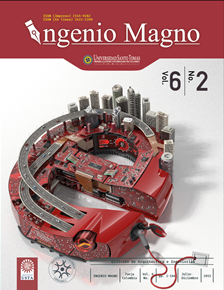Cooperation with sena in the development of videogames using movement capture
Main Article Content
Abstract
Downloads
Article Details
DECLARATION OF ORGINIALITY OF SUBMITTED ARTICLE
With this document, I/We certify that the article submitted for possible publication in the institutional journal INGENIO MAGNO of the Research Center Alberto Magno CIIAM of the University Santo Tomás, Tunja campus, is entirely of my(our) own writing, and is a product of my(our) direct intellectual contribution to knowledge.
All data and references to completed publications are duly identified with their respective bibliographical entries and in the citations thus highlighted. If any adjustment or correction is needed, I(we) will contact the journal authorities in advance.
Due to that stated above, I(we) declare that the entirety of the submitted material is in accordance with applicable laws regarding intellectual and industrial property, and therefore, I(we) hold myself(ourselves) responsible for any complaint related to it.
If the submitted article is published, I(we) declare that I(we) fully relinquish publishing rights of the article to the University Santo Tomás, Tunja campus. As remuneration for this relinquishment of rights, I(we) declare my(our) agreement to receive two (2) copies of the edition of the journal in which my(our) article appears.
References
Chadda, A., Wenjuan, Z., Ming, C. y Xiaoqing, F. (2011). Design, implementation, and evaluation of optical lowcost motion capture system. 31st Computers and Information in Engineering Conference, vol. 2.
Delaney, B. (1998). On the trail of the shadow woman: the mystery of motion capture. Computer Graphics and Applications, 18(5), 14-19.
Dent, S. (2014).. What you need to know about 3D motion capture. Recuperado de http://www.engadget. com/2014/07/14/motion-capture-explainer/
Optitrack (s. f.). Diagrama de un espacio de captura. Recuperado de www.optitrack.com/static/img/ flex13MocapVolume.png
Puthenveetil, S., Daphalapurkar, C., Wenjuan, Z., Ming, C., Xiaoqing, F., Alpha, M., Gilpin-Mcminn, J., Wu, P. y Snodgrass, S. (2013). Comparison of marker-based and marker-less systems for low-cost human motion
capture. 33rd Computers and Information in Engineering Conference, vol. 2B.
Pyeong-Gook, J., Sehoon, O., Gukchan, L. y Kyoungchul, K. (2013). A mobile motion capture system based on inertial sensors and smart shoes. Journal of Dynamic Systems, Measurement, and Control, 136(1).
RenderDigimania. (2015). Affordable mocap for animators. Recuperado de http://renderdigimania.com/ blog/affordable-mocap-for-animators/
Servicio Nacional de Aprendizaje (SENA) (2015, 22 de agosto). Configuración sistema MOCAP. Recuperado de https://www.youtube.com/watch?v=u6c22lrFd6o
Servicio Nacional de Aprendizaje (SENA) (s. f.). Red Tecnoparque Colombia. Recuperado de http:// tecnoparque.sena.edu.co/

